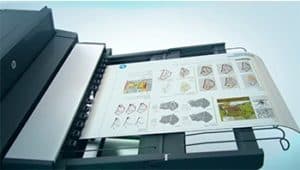Common Printer Problems and How to Fix Them
Is your printer acting up? Read on to learn about common problems and some helpful printer troubleshooting tips to get you back in service.
When an average business prints 400 pages a month, a broken or misbehaving printer is an inconvenience for even the most paper-free companies.
But for the businesses that rely on printing for technical documents, photography, legal work, and more, a defective printer can paralyze workflow and severely impact company performance.
So what do you do when you experience a printer issue?

Well, if you follow this printer troubleshooting guide, we’ll provide some solutions to many common printer problems to get your printer and business running smoothly once again.
1. Paper Jams
Even industrial printers are no strangers to paper jams.
While crumpled or trapped paper is easy to spot in most machines, ignore your immediate reaction to yank the offending paper jam free.
First, it’s advised to turn your printer off and reduce the likelihood of damaging its internal components. If it’s a minor jam and the jammed paper is easily accessible, pinch a corner of the paper and pull it out slowly.
For more complex jams and printers, first, consult the printer’s user guide. These guides often contain a walkthrough specific to your printer and will help you locate an access panel for a deeper look into the machine.
Paper jams are rarely a freak occurrence. Without adjustments, the printer is likely to jam again on subsequent prints.
Ensure you are using paper of the correct size for your printer, and that its tray is correctly aligned.
Old paper absorbs moisture and can cause sheets to stick together. Consider opening a sheaf of fresh papers to avoid future paper jams, if everything else appears to be in working order.
2. Poor-Quality Prints
Your printer may appear to be working normally until you discover it’s printed off hazy, unfocused images or text. While you’re able to continue printing, the terrible quality virtually renders your machine useless.
This is where printer troubleshooting can help.
Unfortunately, there are a variety of reasons why you may be experiencing this printer problem.
If this is a new printer or new device issuing the printing command, the most likely culprit is the driver.
Make sure you’ve installed the correct driver software for your printer to the appropriate device. While printer drivers are often on CDs, they can also be found online.
Certain versions of Windows will automatically search and download the correct drivers when you add the printer to your device.
But if this is your standard printing setup and it’s only now developed this issue, check the level of the ink cartridges. Some printers will allow you to print when their ink is low, but this comes at the cost of significantly reduced quality.
Sometimes the printer heads can become clogged or dysfunctional, reducing the quality of your prints or using the incorrect colors.
On your computer, check the printer’s properties for a maintenance tab. Some printers will have the option to re-align or clean the printer heads and get them back into working order.
3. Not Printing
Perhaps you see your print request idling on your taskbar, or have walked to the printing room to discover that not only is the tray empty, but the printer isn’t operating or making a sound.
Don’t panic. Instead, make sure that you sent the print request to the intended printer. Also, ensure that your device is connected to the company’s Wi-Fi network, so it can communicate the print request to the printer.
Doesn’t seem to be related to your printing device? The printer’s toner may be low, or it could be flashing an error message, so take a quick look at the printer’s display screen.
Assuming your computer or handheld device has the correct print driver, we suggest saving your work and resetting your computer. Sometimes the printing application on your device simply encounters an issue.
Once the computer has been reset, simply send the print request again.
If that doesn’t work, reboot the printer.
4. Printing Slowly
The quality is fine, the prints aren’t getting jammed, but the printer is taking minutes to push out a dozen pages.
If you use a Wi-Fi network to interact with your printer, it’s likely your internet speed is to blame. Your device must upload all the file information to the printer before it can print.
Text-based files shouldn’t be too demanding, but if your print request has lots of images and colors, you may want to consider upgrading your network.
While less efficient, single-sided printing is faster than the double-sided option for those last-minute rush jobs.
Reducing the quality of your prints will increase the printing speed. For internal correspondence, sharpness and detail is often a luxury, not a requirement.
5. I’ve Already Tried Printer Troubleshooting
Over a four year period, only 25% of home printers remain operational. Industrial, business-quality printers are significantly more resilient but have their own host of maintenance and upkeep needs.
If you find yourself troubleshooting often, or if nothing seems to get your printer working to your specifications, there’s a likely explanation: It simply doesn’t work.
It may be time to throw in the towel and purchase a new printer. While this may be a significant expense, you’ll likely make your money back and more if your business is heavily reliant on consistent printer use.
Tired of Troubleshooting?
Even in the digital age, a business of any size can’t escape the necessity that is printing.
Printer troubleshooting is a time-consuming and frustrating process. But if you have a new printer, or simply aren’t ready to upgrade, you’re not out of luck.
Let someone else deal with your printer problems by using our managed print services.